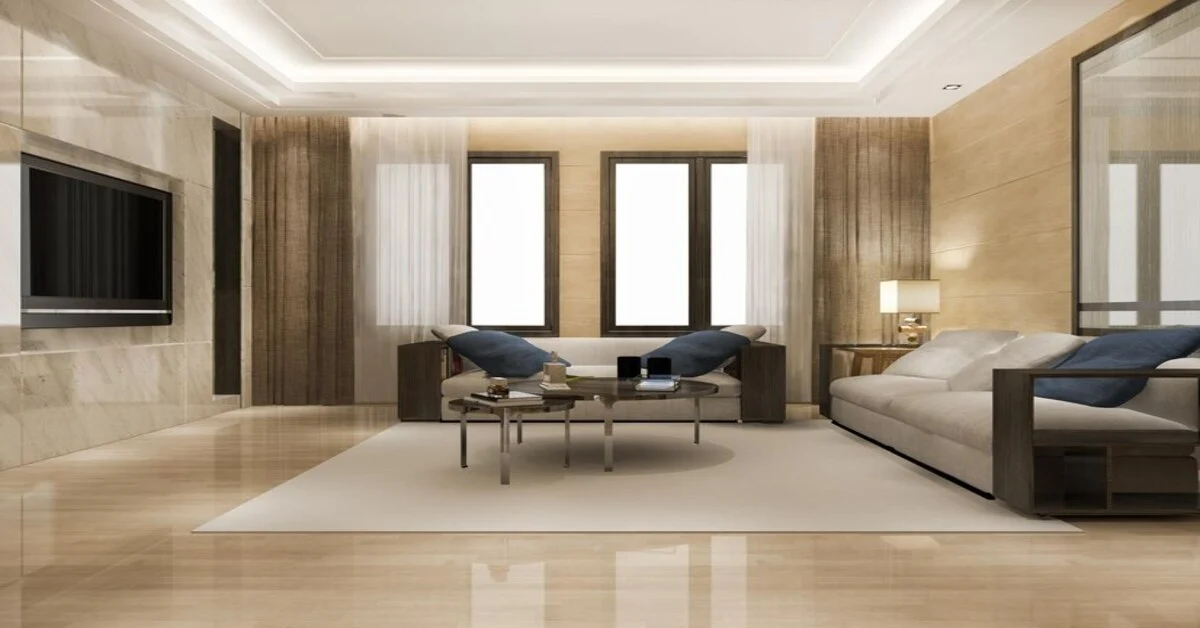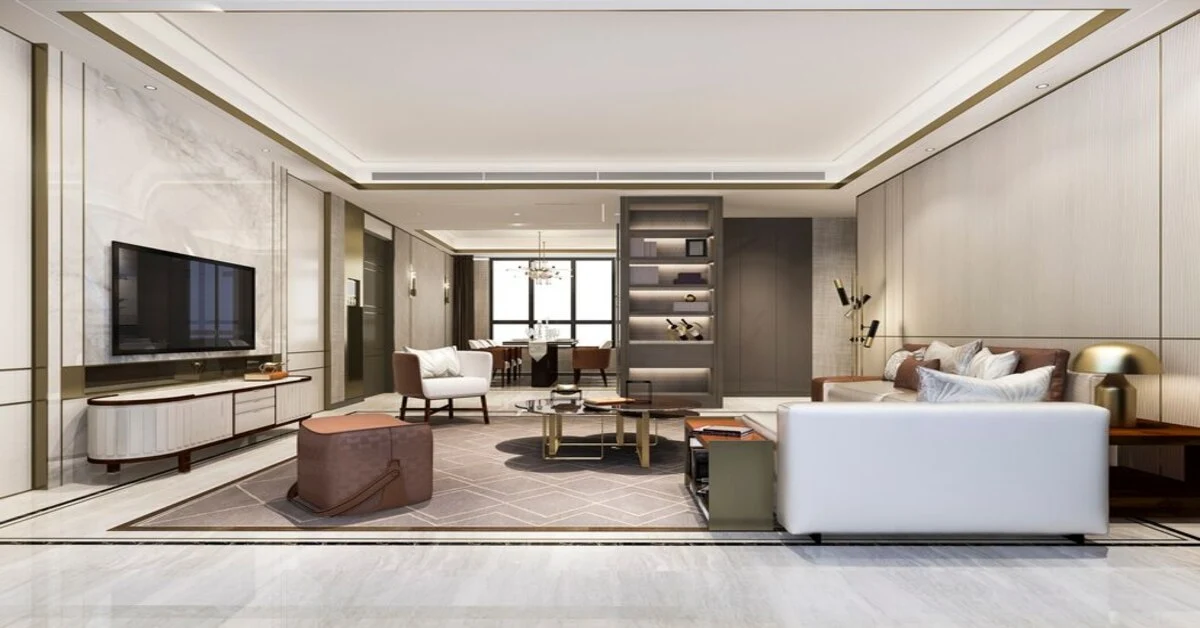False ceilings, commonly known as drop ceilings or suspended ceilings, are secondary ceilings constructed below the main structural ceiling of a room or space. Light partitions, on the other hand, are non-load-bearing dividers often made of glass, gypsum, or other materials, used to create separate sections within a space while allowing light to pass through.
Importance and Benefits of Installing False Ceilings and Light Partitions
- Enhanced Aesthetics: False ceilings add an elegant touch to a room by concealing wirings, ducts, and pipes, providing a polished and seamless appearance. Light partitions, meanwhile, contribute to an open and well-lit ambiance.
- Improved Acoustics: Both false ceilings and light partitions aid in soundproofing by absorbing and reducing ambient noise, offering a quieter environment.
- Energy Efficiency: Light partitions allow natural light to penetrate deeper into space, reducing the need for artificial lighting and promoting energy savings.
- Customization: These installations offer a wide range of design options, enabling customization according to individual preferences and space requirements.
Overview of the Blog’s Focus
In this blog post, we’ll explore the realm of false ceilings and light partitions, uncovering their installation techniques, design factors, material options, and the overall influence these elements can exert on interior spaces. Discovering the transformative potential, a home renovation company in Dubai can bring to these features adds a dimension of expertise to the considerations.
 Exploring False Ceilings
Exploring False Ceilings
What Are False Ceilings?
1. Definition and Purpose
False ceilings, also known as drop ceilings or suspended ceilings, are secondary ceilings installed below the primary structural ceiling of a room or space. Their primary purpose is to enhance the aesthetics of the room, conceal structural components like wiring, ducts, and fixtures, and provide thermal insulation.
2. Types of False Ceilings
Gypsum Ceilings
Gypsum ceilings utilize gypsum boards, offering flexibility in design, ease of installation, and fire-resistant properties. They’re popular due to their versatility and suitability for various design styles.
POP (Plaster of Paris) Ceilings
Known for their smooth finish and ability to create intricate designs, POP ceilings add an elegant touch to spaces. They allow for creativity and customization in design patterns.
Wooden Ceilings
Wooden false ceilings provide warmth and a natural aesthetic. They can range from rustic to contemporary, depending on the type of wood used, making them versatile for different interior styles.
Metal Ceilings
Metal ceilings, often made from aluminum or steel panels, offer durability, sleekness, and resistance to moisture. They’re suitable for modern and industrial design themes.
Advantages of False Ceilings
1. Aesthetic Appeal
False ceilings significantly enhance the visual appeal of a space. They allow for creative designs, textures, and lighting arrangements, transforming the ambiance of a room and adding a touch of sophistication.
2. Concealing Wiring and Fixtures
One of the primary functions of false ceilings is to conceal unsightly wirings, HVAC ducts, lighting fixtures, and pipes. This creates a clean, seamless appearance, enhancing the overall aesthetics of the room.
3. Thermal Insulation and Energy Efficiency
By creating an additional layer, false ceilings contribute to thermal insulation. This helps regulate room temperature, reducing the load on HVAC systems and promoting energy efficiency, thereby lowering utility costs.
Considerations Before Installation
1. Structural Integrity
Before installation, it’s crucial to assess the structural integrity of the existing ceiling. Ensure it can bear the additional weight of the false ceiling materials and fixtures without compromising safety.
2. Design Choices and Customizations
Consider various design options and customizations available for false ceilings. From choosing the type of material and texture to incorporating lighting designs, each decision impacts the final aesthetic and functionality.
3. Cost and Maintenance
Factor in the initial cost of materials, installation, and long-term maintenance. Some materials might have a higher upfront cost but require less maintenance, offering cost-efficiency in the long run.
By understanding the diverse types, advantages, and key considerations involved in false ceiling installations, you can make informed decisions to transform your space with elegance and functionality.
Understanding Light Partitions
Defining Light Partitions
1. Definition and Functionality
Light partitions, also known as translucent partitions, are non-load-bearing dividers used within a space to create sections while allowing light to pass through. These partitions serve to define areas while maintaining an open and airy ambiance.
2. Types of Light Partitions
Glass Partitions
Glass partitions offer transparency, elegance, and a sense of spaciousness. They come in various styles, from clear to frosted or textured glass, catering to different privacy needs.
Acrylic Partitions
Acrylic partitions, known for their durability and lightweight nature, provide a cost-effective alternative to glass. They offer translucency and can be customized in terms of color and opacity.
Benefits of Light Partitions
1. Space Division with Elegance
Light partitions provide a sophisticated way to divide spaces without creating a closed-off feeling. They maintain visual connectivity between areas while defining boundaries elegantly.
2. Enhancing Natural Light Distribution
By allowing light to pass through, light partitions optimize the distribution of natural light within a space. This reduces the need for artificial lighting during daylight hours, promoting energy efficiency.
3. Creating Privacy without Isolation
These partitions strike a balance between privacy and openness. They create separation without completely isolating areas, maintaining a sense of connectivity and collaboration.
Factors to Consider
1. Material Selection
Choose materials based on factors such as durability, desired opacity, and aesthetics. Glass provides a high-end look but may require more maintenance, while acrylic offers durability with easier maintenance.
2. Design Adaptability
Consider design flexibility to ensure the partitions align with the overall aesthetics of the space. Customizable options in terms of color, texture, and size allow for seamless integration into various design schemes.
3. Installation and Maintenance
Ensure professional installation for proper alignment and stability. Additionally, consider maintenance needs; while glass partitions may need regular cleaning, acrylic partitions might require less upkeep but can scratch more easily.
Understanding the functionality, benefits, and considerations associated with light partitions allows for informed decisions when incorporating these elements into interior spaces.
Installation Process
Steps Involved in Installing False Ceilings
1. Planning and Design Phase
Assessment and Measurements
Begin by assessing the space and taking precise measurements. Consider factors such as existing structural elements, lighting fixtures, and the desired height of the false ceiling.
Design Considerations
During the planning phase, finalize the design elements, including the type of false ceiling material, texture, color, and any additional features like recessed lighting or decorative elements.
2. Preparing the Area and Materials
Clearing and Preparing the Space
Clear the area of any furniture or obstacles. Ensure a clean and dust-free environment for the installation process.
Gathering Materials and Tools
Collect the necessary materials based on the chosen false ceiling type. This may include gypsum boards or panels, metal framing components, screws, and specialized tools like saws, drills, and measuring instruments.
3. Installation Techniques
Fixing the Framework
Start by installing the metal framework that will support the false ceiling. Ensure the framework is properly aligned and securely attached to the existing ceiling structure.
Placing the Panels or Tiles
Carefully place and secure the chosen panels or tiles onto the framework. Ensure precision in alignment and spacing to achieve a seamless finish.
Incorporating Lighting Fixtures
If incorporating lighting elements, carefully cut openings or install fixtures within the false ceiling as per the planned design.
4. Finishing and Final Touches
Joint Finishing and Smoothing
Apply joint compounds or fillers to cover any gaps or joints between panels. Smooth out these areas to create a uniform surface.
Painting or Finishing
Apply paint or finishing materials to the false ceiling as per the desired design. Ensure even coverage for a polished look.
Final Inspection and Clean-Up
Conduct a thorough inspection to ensure the installation meets the design specifications. Clean up the area, removing any debris or excess materials.
Steps Involved in Installing Light Partitions
1. Designing the Partition Layout
Assessing Space and Functionality
Begin by evaluating the space where the light partition will be installed. Consider its purpose—whether it’s for privacy, defining sections, or enhancing aesthetics.
Planning the Layout
Design the layout considering the desired height, width, and placement of the partition. Determine whether it will be a full-height partition or a partial divider to maintain visual connectivity.
2. Material Selection and Preparing the Area
Choosing the Partition Material
Select a suitable material based on factors like transparency, durability, and design preferences. Consider options such as glass, acrylic, or other translucent materials.
Preparing the Installation Area
Clear the designated area, ensuring a clean and leveled surface for installation. Gather necessary tools such as drills, screws, and supports according to the chosen material.
3. Installing the Frame and Panels
Constructing the Frame
Start by installing the framework that will support the partition. Ensure accurate measurements and sturdy anchoring to maintain stability.
Installing Panels or Panels
Carefully place and secure the chosen panels or panels within the frame. Ensure precise alignment and fitting to maintain the desired look and functionality.
Securing the Panels
Secure the panels firmly within the frame using appropriate fastening techniques. Ensure the panels are evenly placed and properly aligned.
4. Adding Final Details and Touches
Finishing Edges and Joints
Apply appropriate fillers or finishes to conceal any gaps between panels and the frame. Smooth out surfaces for a seamless appearance.
Adding Enhancements (Optional)
Incorporate additional design elements like decorative strips, frosting, or tinting for added aesthetics or privacy.
Final Inspection and Cleaning
Conduct a thorough inspection to ensure the partition is installed as planned. Clean the area, removing any debris or excess materials.
Practical Applications and Inspirations
Showcasing Real-Life Examples
1. Offices and Workspaces
Practicality in Work Environments
False ceilings and light partitions find extensive use in offices and workspaces. They offer functional advantages like acoustic control, division of open areas for team collaboration, and efficient lighting solutions. Real-life examples demonstrate how these installations contribute to a conducive work atmosphere.
2. Residential Spaces
Transforming Home Interiors
In residential settings, false ceilings and light partitions elevate interior aesthetics while addressing practical needs. They provide design versatility, aid in spatial definition, and enhance natural light diffusion. Showcasing real-life residential applications highlights their role in creating cozy yet stylish living spaces.
3. Commercial Areas
Enhancing Commercial Ambiance
From retail stores to hospitality venues, false ceilings and light partitions contribute significantly to commercial spaces. They help in creating ambiance, and zoning areas, and providing a visually appealing environment for customers. These examples display the adaptability and impact of these installations in diverse commercial settings.
Design Inspirations and Trends
1. Modern Minimalism
Clean Lines and Simplicity
The trend of modern minimalism focuses on clean lines, uncluttered spaces, and simple yet elegant designs. False ceilings and light partitions complement this trend by offering sleek and understated elements that enhance the minimalist aesthetic while maintaining functionality.
2. Contemporary Elegance
Sophistication and Style
Contemporary designs embrace elegance and sophistication. False ceilings and light partitions contribute to this style by incorporating sophisticated materials, unique textures, and subtle lighting effects. They add a touch of class to contemporary interiors.
3. Eclectic Designs
Fusion of Styles and Creativity
Eclectic designs celebrate diversity and creativity. Here, false ceilings and light partitions become canvases for mixing materials, patterns, and unconventional designs. They allow for unique combinations that reflect individual tastes and preferences.
Maintenance and Care
Tips for Maintaining False Ceilings
1. Regular Cleaning Practices
Dusting and Cleaning Surfaces
Use a soft-bristled brush or vacuum cleaner with a brush attachment to remove dust and debris regularly. For hard-to-reach areas, consider using an extendable microfiber duster.
Cleaning Solutions
Prepare a gentle cleaning solution using a mild detergent or a mixture of water and vinegar. Use a soft cloth to gently wipe the surface of the false ceiling to remove stains or dirt.
2. Dealing with Wear and Tear
Addressing Minor Damages
For minor damages like cracks or small holes, use appropriate fillers or joint compounds to repair them. Smooth out the patched areas for a seamless finish.
Handling Water Damage
In case of water damage, identify and fix the source of the leak immediately. Address any water stains on the false ceiling promptly to prevent further damage.
3. Professional Maintenance Checks
Scheduled Inspections
Arrange for periodic inspections by professionals to assess the condition of the false ceiling. Professionals can identify potential issues early and recommend necessary repairs or maintenance.
Maintaining Light Partitions
1. Cleaning Different Materials
Glass Partitions
Clean glass partitions using a mild glass cleaner and a soft cloth to remove fingerprints and smudges. Ensure the cleaner is non-abrasive to prevent scratching.
Acrylic Partitions
For acrylic partitions, use a mixture of mild soap and water with a soft cloth or sponge for cleaning. Avoid abrasive materials that could scratch the surface.
2. Repairing Minor Damages
Handling Scratches
For minor scratches on glass or acrylic surfaces, consider using specialized polishing compounds or kits designed to buff out minor imperfections.
Addressing Cracks or Chips
Repair small cracks or chips in acrylic partitions using acrylic repair kits available in the market. Follow the manufacturer’s instructions for proper application.
3. Longevity and Durability
Proper Handling
Handle partitions with care to prevent accidental damage. Avoid placing heavy objects or applying excessive pressure on the panels to maintain their integrity.
UV Protection (for Acrylic)
Consider UV protective coatings for acrylic partitions if they are exposed to direct sunlight to prevent discoloration or degradation over time.
By following these maintenance tips, you can ensure the longevity and pristine condition of both false ceilings and light partitions, preserving their functionality and aesthetic appeal over time.
 Conclusion
Conclusion
The installation of false ceilings and light partitions elevates the aesthetics, functionality, and ambiance of interior spaces in various settings, be it residential, commercial, or office environments. From defining spatial boundaries to enhancing natural light diffusion, these installations offer practical solutions while contributing to the overall design appeal.
However, their upkeep is equally essential to ensure they maintain their allure and functionality over time. Regular cleaning, timely repairs, and professional maintenance checks are crucial to preserve the pristine condition of false ceilings and light partitions.
By implementing proper care routines and adhering to maintenance guidelines, you can extend the lifespan of these installations while retaining their charm and efficiency.
Whether it’s a contemporary workspace, a cozy home interior, or a vibrant commercial establishment, the careful installation and diligent maintenance of false ceilings and light partitions add a touch of elegance and functionality that truly transforms spaces into captivating environments.
Consider these installations not only as design elements but as investments in enhancing the overall appeal and functionality of your living or working spaces.
Here’s to creating spaces that not only captivate the eye but also provide comfort and efficiency, all achieved through the artful installation and meticulous maintenance of false ceilings and light partitions.







